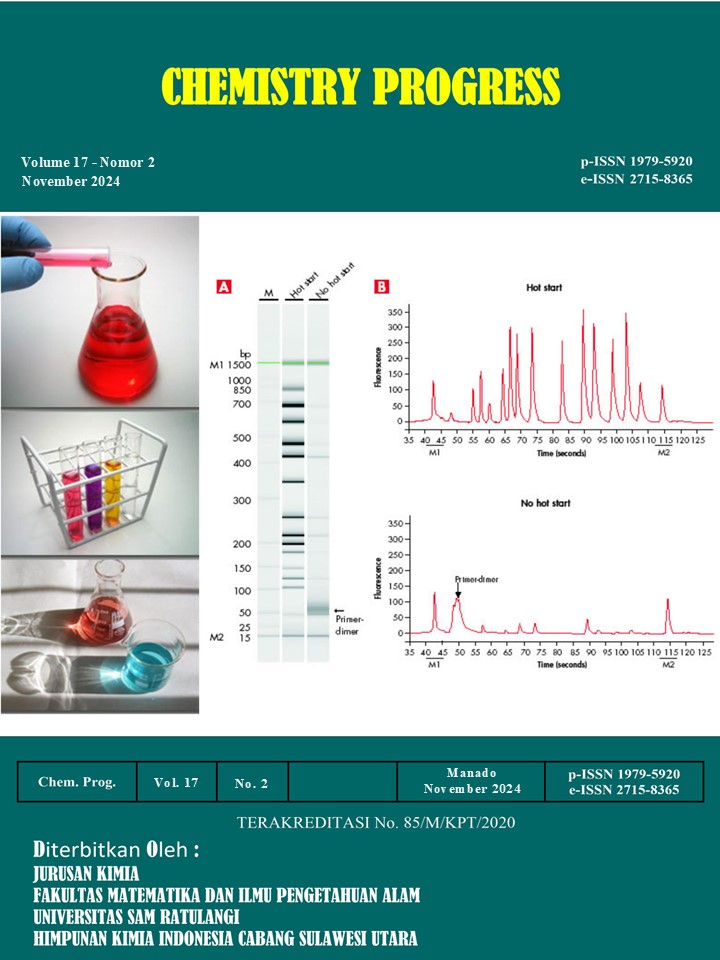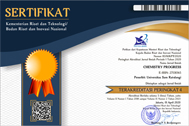Material Berbasis Hidroksiapatit/Zeolit untuk Fotodegradasi Pewarna Sintetik di Bawah Cahaya Tampak
DOI:
https://doi.org/10.35799/cp.17.2.2024.58744Abstract
ABSTRAK
Isu lingkungan terkait pencemaran zat warna sintetis dari limbah industri masih relevan dan terus dikaji. Penelitian ini bertujuan untuk mensintesis material fotokatalis berbahan dasar tulang ikan dan zeolit A (ZA) serta mengaplikasikannya untuk degradasi metilen biru, merah kongo, kristal violet, metil jingga, dan eriochrome black-T dalam larutan air. Tulang ikan dikalsinasi untuk memperoleh hidroksiapatit (HAp) dan HAp yang diperoleh dicampur dengan larutan silikat dan aluminat dalam sintesis zeolit A. Bahan yang dihasilkan kemudian perlakukan dengan AgNO3 dan diperoleh bahan komposit yang selanjutnya dikarakterisasi dengan teknik difraktometri sinar-X. Fotodegradasi zat warna sintetik dilakukan dengan cara menginteraksikan bahan komposit dengan larutan zat warna di bawah penyinaran cahaya tampak dan konsentrasi akhir zat warna diukur dengan spektrofotometer UV-vis. Analisis difraktogram komposit menunjukkan adanya komponen HAp, Ag-ZA, Ag3PO4, dan Ag. Berdasarkan jumlah zat warna yang terdegradasi per satuan massa komposit, komposit ini memiliki kemampuan terbesar dalam mendegradasi eriochrome black-T tetapi sulit untuk mendegradasi metil jingga. Jumlah komposit yang digunakan memengaruhi kemampuan komposit dalam mendegradasi zat warna. Semakin banyak jumlah komposit yang digunakan, semakin rendah jumlah zat warna yang dapat terdegradasi per satuan massa komposit..
ABSTRACT
Environmental issues related to the pollution of synthetic dyes from industrial waste remain relevant and are continuously being studied. This research aimed to synthesize a photocatalyst material based on fish bones and zeolite A (ZA) and apply it for the degradation of methylene blue, congo red, crystal violet, methyl orange, and eriochrome black-T in aqueous solutions. Fish bones were calcined to obtain hydroxyapatite (HAp), and the obtained HAp was mixed with silicate and aluminate solutions in the synthesis of zeolite A. The resulting material was then treated with AgNO3 and a composite material was obtained, which was then characterized using X-ray diffractometry technique. The photodegradation of synthetic dyes was carried out by interacting the composite material with a dye solution under visible light irradiation, and the final concentration of the dye was measured using a UV-vis spectrophotometer. Analysis of the composite diffractogram showed the presence of HAp, Ag-ZA, Ag3PO4, and Ag components. Based on the amount of dye degraded per unit mass of composite, this composite has the greatest ability to degrade eriochrome black-T but has difficulty degrading methyl orange. The amount of composite used affected the ability of the composite to degrade dyes. The more composite used, the lower the amount of dye that could be degraded per unit mass of composite.
Downloads
Published
How to Cite
Issue
Section
License
Copyright (c) 2024 CHEMISTRY PROGRESS

This work is licensed under a Creative Commons Attribution 4.0 International License.













